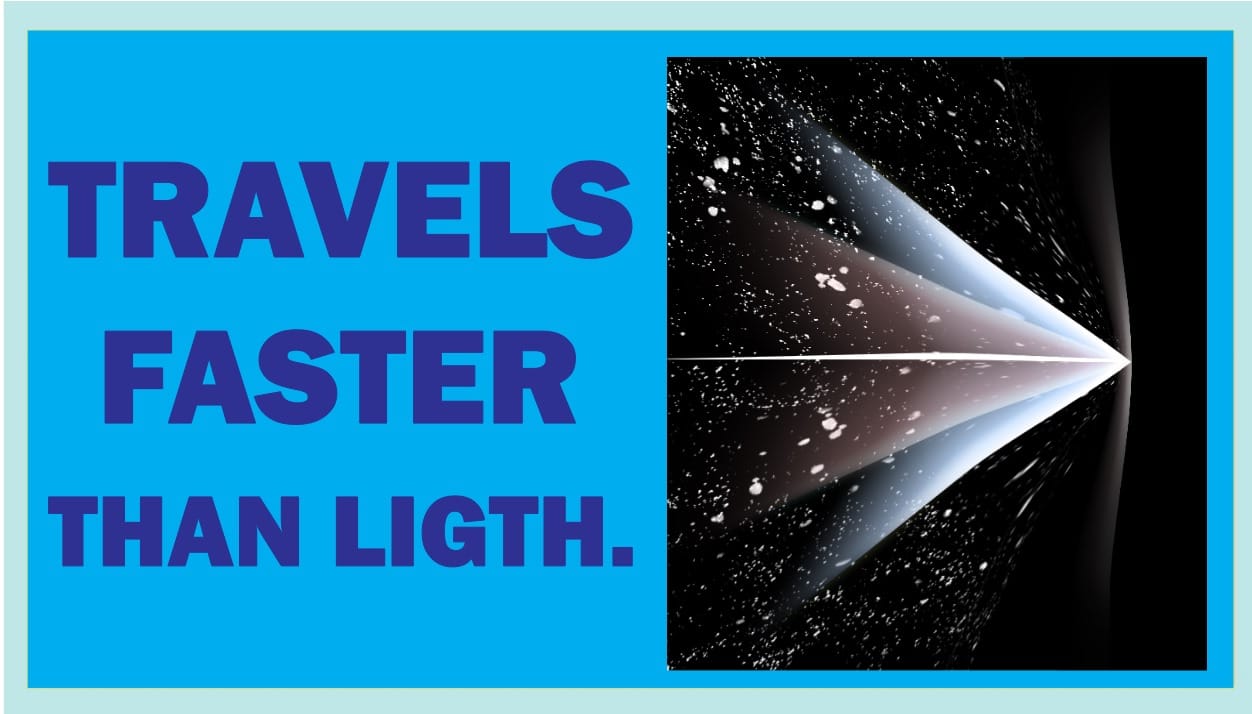introduction What Travels Faster Than Light
What Travels Faster Than Light A constant in our universe, the speed of light is approximately 299,792 kilometers per second (186,282 miles per second), and it has long amazed people. It is renowned for being the fastest thing on the planet. But is that truly the case? What if there are phenomena that could theoretically exceed this cosmic speed limit?
In this article, we’ll dive into intriguing concepts that challenge the supremacy of light’s velocity, breaking them down for enthusiasts and skeptics alike. From theoretical physics to real-world implications, let’s explore what could potentially outpace light.
What Travels Faster Than Light fascinating phenomena that challenge the speed of light, from quantum entanglement to warp drives. Explore scientific breakthroughs, theories, and real-world examples that unravel mysteries beyond physics.
Table of Contents
Understanding the Speed of Light: Why It’s a Big Deal

The speed of light isn’t just another fast-moving entity; it’s the backbone of Einstein’s theory of relativity. Why is this speed so pivotal?
- The Speed Limit of the Universe: Light’s speed sets a cosmic speed limit, ensuring causality—events happen in order, and information travels consistently.
- Relativity’s Foundations: Einstein’s famous equation, E=mc2E=mc^2E=mc2, hinges on light’s speed (ccc). Without it, our understanding of mass-energy equivalence crumbles.
- Everyday Applications: Fiber-optic internet, GPS satellites, and even medical imaging rely on precise calculations involving light speed.
This universal constant feels almost untouchable—but cracks in this belief exist.
Quantum Entanglement: Instantaneous Communication?

Imagine particles so intertwined that a change in one instantly affects the other, no matter the distance between them. From the exciting world of quantum entanglement, greetings.
How It Works:
- Two particles become entangled through quantum processes.
- When one particle’s state changes, the other mirrors it instantaneously—even if separated by galaxies.
Faster-Than-Light Implications:
Though no actual “information” is transmitted in the classical sense, this spooky action at a distance hints at phenomena faster than light. Quantum computing harnesses these properties, promising unimaginable speedups in data processing.
Real-Life Example: The University of Science and Technology of China achieved entanglement over 1,200 kilometers using a satellite, showcasing its vast potential.
The Expansion of the Universe: Galaxies Racing Beyond Light

There is a paradox here: space itself can grow more quickly than light, even though nothing can travel through space faster than light. During the Big Bang, the universe expanded exponentially, a process known as cosmic inflation.
Why It Happens:
- Space-time fabric itself isn’t bound by relativity’s constraints.
- Galaxies far enough apart are carried by expanding space faster than light can travel.
What Travels Faster Than Light Implications:
This doesn’t violate physics; rather, it redefines how we perceive “motion.” Light emitted from these galaxies may never reach us, effectively placing them beyond our observable universe.
Case Study: Observations from the Hubble Space Telescope suggest galaxies at the edge of our vision are receding faster than light due to this expansion.
Tachyons: Hypothetical Faster-Than-Light Particles

If light is fast, tachyons are theoretical particles that could outstrip it by design. First proposed in the 1960s, tachyons exist only in the realm of mathematics—for now.
Key Characteristics:
- Ever since their “birth,” tachyons have been able to fly faster than light.
- They gain speed as they lose energy, defying conventional physics.
Challenges:
So far, there’s no experimental evidence for tachyons. Yet, their potential inclusion in quantum field theories keeps scientists intrigued.
Potential Use Case: If tachyons exist, they might revolutionize communication, enabling instantaneous data transfer over vast distances.
Warp Drives: Science Fiction Meets Reality

Who hasn’t dreamed of interstellar travel in the vein of Star Trek? The concept of a warp drive might bring this fantasy closer to reality.
How It Works:
- This allows the ship to “travel” faster than light relative to outside observers.
Current Progress:
A scientist named Miguel Alcubierre proposed a theoretical framework for this type of propulsion. While it requires exotic matter with negative energy, breakthroughs in quantum physics may make this less far-fetched.
Real-Life Application: NASA’s Eagle works Laboratory has explored early-stage concepts resembling warp drives, signaling hope for future developments.
Cherenkov Radiation: When Particles Outrun Light in a Medium

Did you know light can be outrun under certain conditions? While the universal speed limit of light in a vacuum remains unbroken, light slows down when traveling through various materials, What Travels Faster Than Light such as water or glass. This phenomenon makes Cherenkov radiation possible.
What Is Cherenkov Radiation?
- When charged particles, such as electrons, move faster than light does in a medium, they emit a faint blue glow called Cherenkov radiation.
- The sound is comparable to a sonic boom, however light is used in place of sound.
Applications in Science:
- Cherenkov radiation is a crucial tool in nuclear reactors and particle accelerators, helping scientists detect high-energy particles.
- It’s also used in astronomy to study cosmic rays and neutrinos.
Real-Life Example: The Super-Kamiokande Observatory in Japan uses Cherenkov radiation in water to study neutrinos, tiny particles that barely interact with matter.
Hypothetical Phenomenon: Wormholes and Instant Travel

Wormholes, theoretical shortcuts through space-time, may allow faster-than-light travel in a roundabout way. Picture folding a piece of paper and punching a hole through it—that’s a simple analogy for how wormholes work.
How Wormholes Could Work:
- They connect two distant points in space-time.
- A traveler passing through would effectively “skip” the intervening space, arriving faster than light could.
Challenges and Theories:
- Wormholes require massive amounts of exotic matter to stabilize.
- They might exist only momentarily, collapsing before anything could travel through them.
Science in Progress: Researchers like Kip Thorne have explored wormholes theoretically, inspiring science fiction and guiding experiments in quantum gravity.
Neutrinos: The Almost Faster-Than-Light Particles

Neutrinos, nearly massless particles, have been at the center of debates about faster-than-light speeds. In 2011, an experiment by CERN suggested that neutrinos might have exceeded light speed, though it was later found to be a measurement error.
Why Neutrinos Fascinate Scientists:
- They move at extremely near-light speeds.
- Neutrinos pass through matter almost undisturbed, making them ideal for studying the universe’s most elusive secrets.
Real-Life Implications:
While they’re not faster than light, understanding neutrinos helps scientists explore supernovae, black holes, and even the early universe.
Information Paradoxes in Black Holes
Black holes, regions of space with immense gravity, warp space-time in extreme ways. The concept of Hawking radiation, theorized by physicist Stephen Hawking, suggests that particles can escape black holes, hinting at phenomena that may challenge light-speed limits.
Faster-Than-Light Theories in Black Holes:
- Inside a black hole’s event horizon, space-time curves so drastically that normal rules of speed break down.
- Information paradoxes arise, questioning how quantum information can “escape” the gravitational pull.
Case Study: The Event Horizon Telescope captured the first image of a black hole in 2019, offering clues about how black holes interact with light and matter.
The Universe’s Acceleration Due to Dark Energy

Dark energy, a mysterious force driving the universe’s accelerated expansion, could hold clues about phenomena exceeding light speed. It’s responsible for galaxies moving apart at rates faster than light in some cases.
What Is Dark Energy?
- It acts against gravity and makes up around 68% of the cosmos.
- It explains why the universe’s expansion is speeding up rather than slowing down.
Scientific Implications:
Studying dark energy may unlock answers about the universe’s fate, potentially challenging our understanding of light-speed boundaries.
Real-Life Example: Observations from the Sloan Digital Sky Survey have helped map dark energy’s effects on cosmic structures.
Theoretical Frameworks: Beyond Relativity
Einstein’s theory of relativity is incredibly robust, but scientists constantly test its limits. Some alternative theories suggest scenarios where faster-than-light travel or communication might occur.
Examples of Alternative Theories:
- String Theory: Proposes extra dimensions where light-speed limits might differ.
- Loop Quantum Gravity: Investigates space-time at the smallest scales, potentially redefining speed limits.
Why This Matters:
Challenging established physics isn’t about disproving Einstein—it’s about expanding our knowledge and refining our understanding of the universe.
The Fermi Paradox and Interstellar Travel

Given the size of the cosmos, why haven’t we come across extraterrestrial civilizations? The Fermi Paradox suggests possible solutions, some involving faster-than-light travel.
Faster-Than-Light in the Fermi Context:
- Advanced civilizations might use warp drives or wormholes to explore the cosmos.
- If such technologies exist, it could explain why aliens haven’t used traditional communication methods.
What Travels Faster Than Light Real-Life Search:
Projects like SETI (Search for Extraterrestrial Intelligence) scan the skies for signs of alien life, keeping an open mind about faster-than-light possibilities.
The Philosophy of Speed: What Truly Travels Fastest?
Beyond physics, certain concepts seem to defy light’s speed effortlessly.
Instantaneous Concepts:
- Thought: The human mind can “travel” across the universe in an instant through imagination.
- Love and Connection: While intangible, these emotional bonds transcend space and time in ways science struggles to explain.
Why This Resonates:
While light-speed might govern the physical universe, our perceptions and emotions often feel limitless.
Real-World Impacts of Faster-Than-Light Studies

Studying faster-than-light phenomena isn’t just academic—it has practical implications.
Potential Applications:
- Space Exploration: Breakthrough propulsion methods could make interstellar travel feasible.
- Communications: Instantaneous data transfer could revolutionize industries from medicine to finance.
Progress in the USA:
Institutions like NASA and the Department of Energy invest heavily in research, pushing boundaries to bring these concepts closer to reality.
The Future: Will We Ever Travel Faster Than Light?
The dream of faster-than-light travel inspires scientists and storytellers alike. While it may remain a distant goal, continued exploration of space, time, and quantum mechanics keeps the hope alive.
Key Questions:
- Can we harness exotic matter for warp drives?
- Will quantum breakthroughs unlock faster-than-light communication?
A Final Thought:
What travels faster than light might not exist in our physical realm—yet. But human ingenuity ensures we’ll keep chasing these cosmic mysteries.
What Travels Faster Than Light Conclusion
From quantum entanglement to warp drives and the expansion of space itself, the idea of surpassing light’s speed captivates scientists and dreamers. What Travels Faster Than Light While the speed of light remains a defining constant of our universe, these concepts challenge its supremacy and fuel exciting possibilities for the future.
Get more Detail
How fast is light? How many miles per second?
The speed of light is approximately 186,282 miles per second in a vacuum.
Has anything been proven to travel faster than light?
No direct evidence exists, but phenomena like quantum entanglement and cosmic expansion challenge the speed limit in unconventional ways.
Are warp drives scientifically possible?
Theoretical models exist, but they require exotic matter, making them impractical with current technology.
Why does physics care so much about the speed of light? in physics?
It serves as the foundation for Einstein’s theory of relativity and governs how energy, mass, and information interact in our universe.
What’s the role of dark energy in faster-than-light phenomena?
Dark energy drives the accelerated expansion of the universe, causing galaxies to recede from us at speeds exceeding light.
